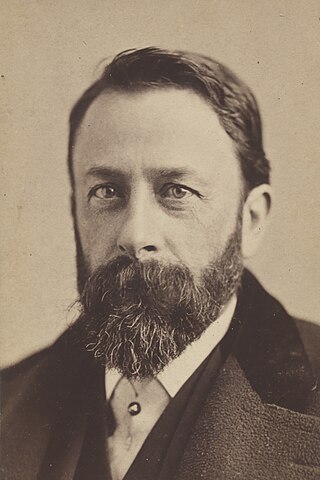
Albert Bierstadt was a German American painter best known for his lavish, sweeping landscapes of the American West. He joined several journeys of the Westward Expansion to paint the scenes. He was not the first artist to record the sites, but he was the foremost painter of them for the remainder of the 19th century.

Thomas Hill was an American artist of the 19th century. He produced many fine paintings of the Californian landscape, in particular of the Yosemite Valley, as well as the White Mountains of New Hampshire.

Jules Tavernier was a French painter, illustrator, and member of Hawaii’s Volcano School.

Emerson Seville Woelffer was an American artist and arts educator. He was known as a prominent abstract expressionist artist and painter and taught art at some of the most prestigious colleges and universities. Woelffer was one of the important people in bringing modernism to Los Angeles, when he taught at Chouinard Art Institute.

Chiura Obata was a well-known Japanese-American artist and popular art teacher. A self-described "roughneck", Obata went to the United States in 1903, at age 17. After initially working as an illustrator and commercial decorator, he had a successful career as a painter, following a 1927 summer spent in the Sierra Nevada, and was a faculty member in the Art Department at the University of California, Berkeley, from 1932 to 1954, interrupted by World War II, when he spent a year in an internment camp. He nevertheless emerged as a leading figure in the Northern California art scene and as an influential educator, teaching at the University of California, Berkeley, for nearly twenty years and acting as founding director of the art school at the Topaz internment camp. After his retirement, he continued to paint and to lead group tours to Japan to see gardens and art.

Jack Thomas Cassinetto was a prolific California plein air artist of the tonalism movement who painted primarily Northern California landscapes such as Lake Tahoe, Yosemite, the Gold Country, the Northern California Coast, and the American River and Sacramento River.

William Keith was a Scottish-American painter famous for his California landscapes. He is associated with Tonalism and the American Barbizon school. Although most of his career was spent in California, he started out in New York, made two extended study trips to Europe, and had a studio in Boston in 1871–72 and one in New York in 1880.

Gunnar Mauritz Widforss was a Swedish American artist who specialized in painting subjects from the wilderness in watercolor. Widforss is most frequently associated with landscapes from American National Parks.

William Seltzer Rice was an American woodblock print artist, art educator and author, associated with the Arts and Crafts movement in Northern California.

John Englehart or Joseph John Englehart (1867–1915), was an American landscape painter who worked under a number of pseudonyms. Englehart was born on June 14, 1867, in Chicago, Illinois, and died on April 14, 1915, in Oakland, California.

Carl Eytel was a German American artist who built his reputation for paintings and drawings of desert subjects in the American Southwest. Immigrating to the United States in 1885, he settled in Palm Springs, California in 1903. With an extensive knowledge of the Sonoran Desert, Eytel traveled with the author George Wharton James as he wrote the successful Wonders of the Colorado Desert, and contributed over 300 drawings to the 1908 work. While he enjoyed success as an artist, he lived as an ascetic and would die in poverty. Eytel's most important work, Desert Near Palm Springs, hangs in the History Room of the California State Library.
Charles Dorman Robinson was an American panorama, cyclorama, landscape, and marine painter. He is known for his seascapes and landscapes of Northern California, including over a hundred paintings of Yosemite Valley. He was known as "the dean of Pacific Coast artists".

Eliza Barchus was an American landscape painter who lived in Portland for most of her life. Born in Salt Lake City, Utah, Barchus moved to Portland in 1880. After taking art lessons from another landscape painter, Will S. Parrott, Barchus sold her first painting in 1885. Between then and 1935, she produced thousands of oil paintings and reproductions of subjects such as Mount Hood, Yellowstone Falls, Muir Glacier, and San Francisco Bay.

Grafton Tyler Brown was an American painter, lithographer and cartographer. Brown was the first African-American artist to create works depicting the Pacific Northwest and California.
Ransom is a male given name which may refer to:
Robert Boardman Howard (1896–1983), was a prominent American artist active in Northern California in the first half of the twentieth century. He is also known as Robert Howard, Robert B. Howard and Bob Howard. Howard was celebrated for his graphic art, watercolors, oils, and murals, as well as his Art Deco bas-reliefs and his Modernist sculptures and mobiles.
Clayton Sumner "C. S." Price was an American expressionist painter from Oregon.

Tilden Daken was an American landscape painter known primarily for his oil paintings of the California redwoods, the Sierra Nevada mountains, and the countryside scenery of Northern California and Southern California. He also painted in Alaska, Mexico, Baja, the Hawaiian Islands, the South Seas, and parts of the East Coast of the United States.

Ferdinand Burgdorff,, also known as Ferdy, was an American etcher, painter, and printmaker. He was nationally known for his role as a landscape painter of the Monterey Peninsula, Yosemite, and the dessert Southwest. He was one of the earliest artist that came to the art colony in Carmel-by-the-Sea. He was an illustrator for Sunset Magazine. His works can be found in the permanent collections of the Naval Postgraduate School, De Young Museum, Monterey Museum of Art, and the Cleveland Museum of Art.


















